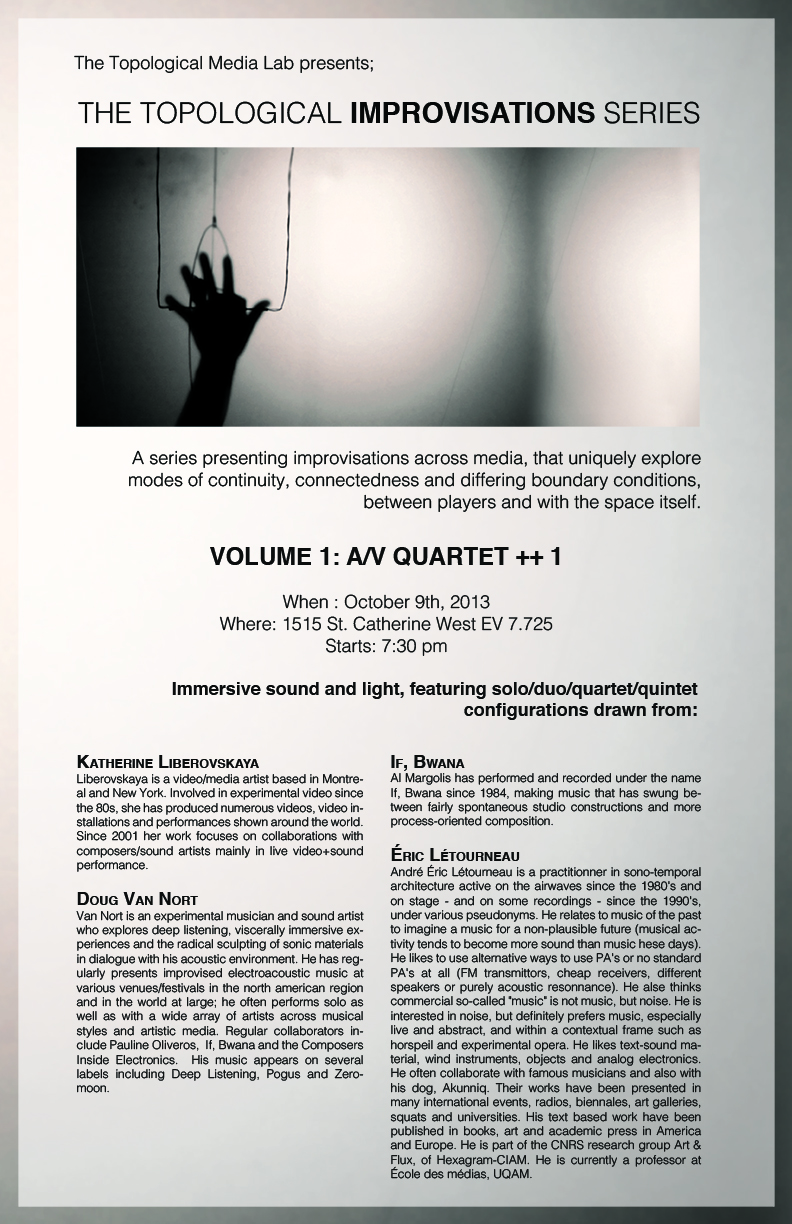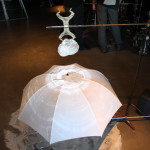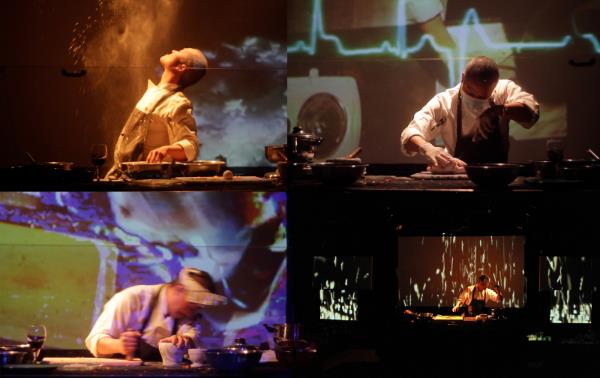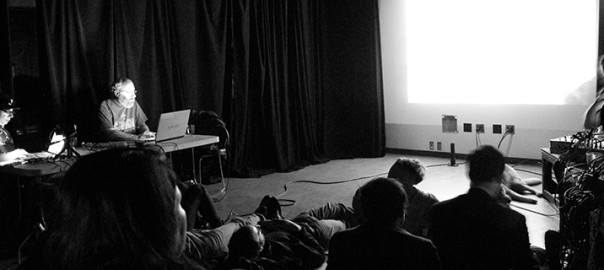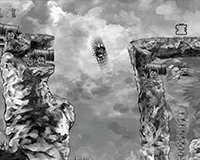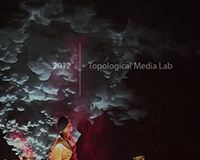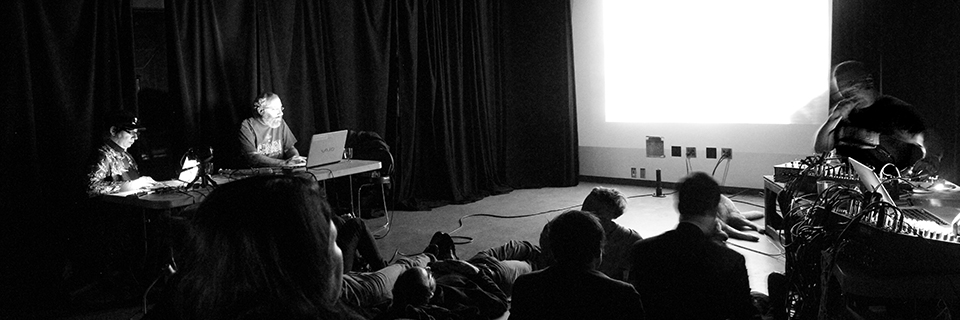
T.I : VOL.1 : A/V QUARTET ++1
Immersive sound and video, featuring solo/duo/quartet/quintet configurations drawn from: If, Bwana (electronics, objects) / Doug Van Nort (voice, electronics) / Katherine Liberovskaya (live video) / Éric Létourneau (synths, gamelan, wind instruments) / Akunniq (the dog)
WHEN :FEBRUARY 20TH, 2014
WHERE: 1515 ST. CATHERINE WEST EV 7.725
TIME: 7:30 PM, PWYC
[wpsgallery]
ÉRIC LÉTOURNEAU
André Éric Létourneau est actif dans le milieu radiophonique, les mondes des arts électroniques, audios et de l’art-action depuis la fin des années 1980. Il s’intéresse particulièrement à l’usage des médias par les groupes marginalisés, à la sphère publique comme contexte d’intervention, aux pratiques artistiques furtives et à une approche sociologique et sociopolitique de l’art et des médias. Réalisateur, animateur et concepteur d’émissions, il a régulièrement travaillé pour Radio-Canada et pour différentes radios publiques, communautaires et Web. Artiste en création radiophonique et en médias électroniques, ses oeuvres furent diffusées par Radio-France, KunstRadio (Radio nationale autrichienne), Radio Heklsinki, Radio Métropole (Haïti) et à la Walter Phillips Gallery (Banff Centre). Il a réalisé de nombreux projets à l’étranger et dans le cadre de résidences d’artistes, particulièrement en Indonésie où il a intensivement étudié le théâtre d’ombre balinais et la médiatisation de la tradition orale, ainsi qu’à l’ArtEZ Hogeschool Voor de Kunsten où il a poursuivi, sur une période intensive de 8 mois, une série d’interventions radios et vidéographiques à travers les Pays-Bas. Ses projets artistiques furent présentés dans une cinquantaine de festivals et d’événements internationaux, plus récemment à la Biennale d’Afrique de l’est (EASTAFAB-BURUNDI), Grace Exhibition Space (New York), Steirischer Herbs (Autriche), la Biennale de Paris, au Centre canadien d’architecture et par la Electronic Music Foundation. Ces dernières années, il a donné des workshops à l’Institut d’études politiques de Paris (SciencesPo.), l’Union des artistes, l’École des Beaux-Arts de Saint-Brieuc, au RAIQ et à la Chaire de recherche en dramaturgie sonore au théâtre de l’UQAC. Actif au sein du centre Dare-Dare et du Regroupement des arts Interdisciplinaires du Québec, il est membre d’Hexagram UQAM et de l’unité de recherche CNRS Art & Flux.
DOUG VAN NORT
Doug Van Nort is an experimental musician and sound-focused artist who explores deep listening, viscerally immersive experiences and the radical sculpting of sonic materials in dialogue with his acoustic environment. He has been highly active in the performance of improvised electroacoustic music in recent years at venues such as the Stone, Roulette, Issue Project Room, the New Museum, Experimental Intermedia, the Red Room, Studio Soto, Casa del Popolo, the Guelph Jazz festival, Xfest, EMPAC, and numerous other venues/festivals in the north american region and in the world at large; he often performs solo as well as with a wide array of artists across musical styles and artistic media. He collaborates regularly with Pauline Oliveros, Al Margolis and the Composers Inside Electronics, and in recent years he has performed and recorded with dozens of artists including Francisco López, Stuart Dempster, Chris Chafe, Kathy Kennedy, Ben Miller, Alessandra Eramo, David Arner, Anne Bourne, Eric Leonardson, Judy Dunaway, Katherine Liberovskaya, Carver Audain, André Éric Létourneau, Jefferson Pitcher, Jonathan Chen, and in Sarah Weaver-led ensembles alongside the likes of Gerry Hemingway, Min Xiao-Fen, Franz Hackl, Mark Helias and Dave Taylor. His music appears on several labels including Deep Listening, Pogus and Zeromoon and his writings on sound/performance/technology have been published in a variety of sources such as the Leonardo Music Journal and Organised Sound.
KATHERINE LIBEROVSKAYA
www.liberovskaya.net.
Katherine Liberovskaya is a video and media artist based in Montreal, Canada, and New York City. Involved in experimental video since the 80s, she has produced many single-channel videos, video installation works and video performances which have been presented at a wide variety of artistic venues and events around the world. Since 2001 her work predominantly focuses on collaborations with composers and sound artists notably in live video+sound performance where her live visuals seek to create improvisatory “music” for the eyes. Frequent collaborators include Phill Niblock, Al Margolis/If,Bwana, Zanana, Kristin Norderval, Hitoshi Kojo, David Watson, David First and o.blaat (Keiko Uenishi). Since 2003 she has explored improvised video with numerous artists including: Margarida Garcia, Anthony Coleman, Barry Weisblat, Mazen Kerbaj, murmer, André Gonçalves, Monique Buzzarté, Giuseppe Ielasi, Renato Rinaldi, Alessandro Bossetti, Andre Eric Letourneau, Jason Khan, Jim Bell, among many others. Recent projects have involved: Shelley Hirsch, Chantal Dumas, Leslie Ross, Richard Garet, Dorit Chrysler, Emilie Mouchous, Erin Sexton, Corinne René and Philippe Lauzier. Concurrently she curates and organizes the Screen Compositions evenings at Experimental Intermedia, NYC, since 2005 and the OptoSonic Tea series at Diapason, NYC, and in various locations in Europe and elsewhere with OptoSonic Tea On the Road.
IF, BWANA
Al Margolis has performed and recorded under the name If, Bwana since 1984, making music that has swung between fairly spontaneous studio constructions and more process-oriented composition. He is known as an activist of the 1980s American cassette underground through his cassette label Sound of Pig Music, and is the co-founder of experimental music label Pogus Productions <http://www.pogus.com>. Margolis is label manager for Deep Listening and XI Records; plays bass guitar in the legendary punk/post-punk band Styrenes; and continues his work as If, Bwana. He has recorded and/or performed with Pauline Oliveros, Ione, Joan Osborne, Monique Buzzarté, Adam Bohman, Ellen Christi, Fred Lonberg-Holm, Jane Scarpantoni, Ulrich Krieger, David First, and Dave Prescott, among others. Recent projects include: a duo with Tom Hamilton (electronics and objects), a laptop duo with Doug Van Nort, and a violin/bass duo with James Ilgenfritz, and an ongoing collaboration with video artist Katherine Liberovskaya.
